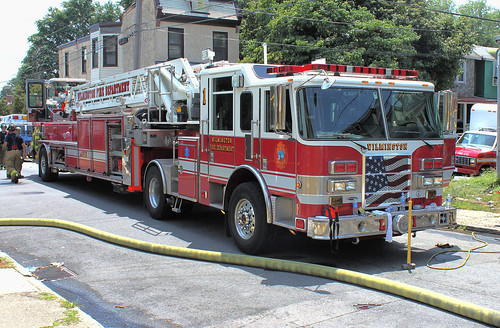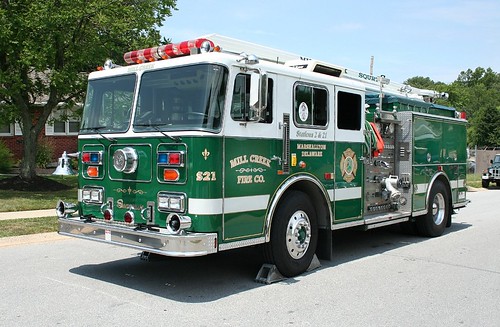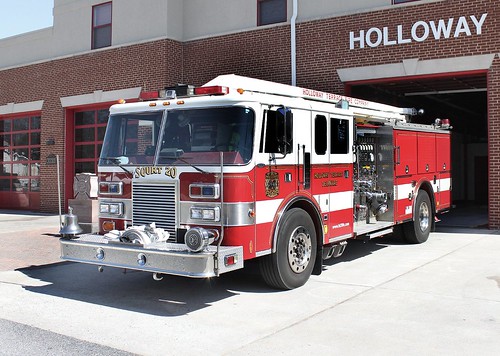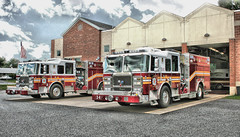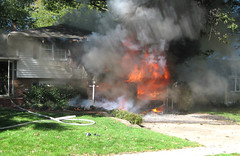In its largest apparatus order in a decade, the Philadelphia Fire Department has contracted with KME Kovatch to manufacture a total of 21 1500gpm pumpers on the new severe service chassis. Delivery is expected to continue through 2012.
Commentary on the world's most admired professions by firefighter and filmmaker, Lou Angeli.
Friday, November 11, 2011
Thursday, October 20, 2011
Saving Firefighter Ryan
by: Lou Angeli
Flashover! Even though firefighters are beginning to understand it, this fatal phenomenon is still shrouded in a veil of mystery. Experts in the fire training arena have differing opinions and descriptions of Flashover, but they all seem to agree on one thing. It's a nasty thing!
Simply put, room and contents begin to burn at a very rapid rate during the growth stage of the blaze. Heat is radiated from burning combustibles, then reradiated by the walls and other structural elements. This "thermal feedback" causes an even greater acceleration of heat. Finally, the entire room and its contents ignite with violent and explosive force.Our culture and its technology have served as a major contributor to the problem of flashover.
Up until the 1960's, the average residence contained natural products made up of woods, cottons and other fabrics. Back then it often took a blaze from 8 to 10 minutes to grow from inception to the fully-involved stage. But in our present day world of synthetics, plastics and hydrocarbons, the same room takes only 2 to 3 minutes to reach the peak of fire growth. This accelerated rate of burn has become a major concern for firefighting teams and the officers who command them.
Oddly enough, it was a prevention tool designed to save lives that first brought Flashover to our attention - the home smoke detector. In days gone by, fires were typically unreported until they vented from a window, sending the fastest civilian running for the Gamewell Box.
Today, because of the effectiveness of early warning systems, departments are now notified of fires much, much earlier.Companies now arrive on the scene during the growth stage, entering the structure at the worst possible time, just prior to flashover. Combine this with the standing practice of aggressive interior attack, and one can quickly understand why firefighters have become more aware, and much more concerned, of the phenomenon.
The simple fact is - we're seeing Flashover conditions much more often.
Low Tech System - High Tech Results
In Europe, where line of duty deaths, and interior attack, are quite rare, the multi-national fire community was shocked, when in 1987, two Swedish firefighters lost their lives to a flashover incident.
In response, training officers in Stockholm saw the need to create an awareness program for the brigade's firefighters. They developed a rudimentary simulator that allows attack teams to identify potentially dangerous environments during the early stages of the firefight. Their primary goal: to demonstrate to suppression teams how to escape a flashover and exit safely.
On the fire training grounds near Stockholm, I prepare to videotape the special fire training simulator designed by the Swedes. I was expecting a high-tech block structure, with thermal sensors, gas jets, and emergency sprinklers. Instead, I'm led to a series of overseas shipping containers, that have been laid out in random fashion to represent various firefighting scenarios.
According to Roland Lindquist, Director of the Raddnings Verket, (The Swedish Fire Rescue Services Board) the system was adopted by all departments in Sweden by 1990. Instructors there further refined both classroom and hands-on curriculum, and today every Swedish firefighter is required to take this special training course. It's dubbed the Swede Survival System, and it's taken Europe, and this nation, by storm.
6,000 miles away from Stockholm, in America's heartland, Indianapolis firefighters carry on a tradition that's been passed down from generation to generation -- mounting an aggressive interior attack. Like so many departments nationwide, Indy fire administration have armed all front-line personnel with the very best in protective equipment. A secure envelope, that guards firefighters from intense heat and vicious flames.
But some say that this very same envelope denies firefighters the use of an important God-given safety regulator – the sense of feel. In short, present day protective gear is so damned good, it's difficult to determine when to bail out.
A 3-alarm blaze in Indy's downtown section, found three firefighters deep inside the bowels of the beast. A huge structure, the Athletic Club blaze was stubborn, and difficult to ventilate. According to other interior personnel, the trio entered a smoky room in search of the seat of the fire, but within moments the room erupted in an explosion of flame, instantly snuffing out their lives.
IFD was determined to prevent similar horrible accidents from ever happening again. They imported the Swede Survival System, and since its installation, EVERY IFD firefighter and officer has received extensive flashover training. Many, more than once.
In other departments throughout the USA, training officers have adapted the system to meet the needs of America's aggressive firefighters. Their goal, to show an uncontrolled blaze in a SAFE, controlled atmosphere. And to date, nearly fifty departments and agencies have answered the call.
----
(1) Swede Survival Systems (Drager Safety)
Copyright 2011, Lou Angeli, All Rights Reserved
The New View from Ten House
For so many years, firefighters at FDNY Station-10 were reminded of 9/11/01 by the giant hole that stood just 50 yards from their station. Today, the view is much different, and although we will NEVER FORGET what happened, the new view from Ten House reveals what Americans do following horror and disaster -- they rebuild. Thanks to all of the trade unions for taking One World Trade to the 75th Floor in time for the 10th Anniversary.
###
Sunday, September 25, 2011
Ladder-1 Wilmington (DE)
Wilmington (DE) Ladder-1 - A 2007 Pierce 100ft TDA -- operating at a 2-alarm residential fire in the city's north side. Heat index was 118F and all firefighters were sent to REHAB for evaluation after 20 minutes. Ladder 1 is housed with Squrt 4 at Station-4.
photo by: Lou Angeli
Friday, June 24, 2011
New Delivery: Rescue-23, Minquaas Fire Company
New Delivery: This 2011 Pierce Heavy Rescue is now in service with the Minquas Fire Company, Station 23, of Newport, Delaware. Rescue-23 and its crew see a great deal of action on the heavily congested section of Interstate 95, which runs through northern Delaware.
###
Thursday, June 16, 2011
New Critical Care Ambulances for Nemours
Nemours forms In-House Critical Care Transport Team
Wilmington, DE (June 16, 2011) -- Nemours Kids Transport, operating from A.I. duPont Hospital for Children in Wilmington, DE, has taken delivery of three 2011 Ford/Horton Type III ambulances. Following stocking and a 4 state inspection tour, these new ambulances will serve with AIDHC's newly-formed critical care transport team. AI hospital will be the third in the Wilmington area to transition to an in-house team with purpose-built equipment. St Francis Hospital operates the BLS system for the city of Wilmington, with Christiana Care operating transport and CC units both at Christiana and Wilmington Hospitals.
###
Wednesday, May 25, 2011
Devastation as far as the Eye Can See
Joplin, MO (May 24, 2011) -- I'm a former Missourian and returning to Joplin is bittersweet. I had done some EMS training at St. John's Healthcare and my son lives nearby. Today, I had the opportunity to embed with Missouri USAR Task Force-1 our of Columbia. The last time I saw many of these Firefighters, Medics and Volunteers was during the rescue & recovery at Ground Zero in NYC.
But there was no discussion about the World Trade Center nor other past jobs. Today's focus was on finding victims and recovering of bodies at the Home Depot Store on E. 20th Street - Joplin's OWN Ground Zero from Sunday evening's EF5 Tornado.
During the Wedge-shaped multi-vortex twister, many shoppers sought refuge along the concrete walls that lined the front of the store. They would have been much better off laying low in the open center of the structure. Hammered by 200 + Mile Per Hour winds, the concrete facades quickly failed and fell inward crushing those who believed the walls would block the force of the winds and flying debris.
Yesterday morning, Missouri Task Force-1 - operating with 70 Rescuers - took on the grim job of removing smashed concrete in order to recover the dead. The operation included about 10 large Cat Backhoes with grapplers, a scene reminiscent of New York's Ground Zero.
Once the concrete had been moved, four canine search teams began the job of walking through the debris in order to determine specific locations of the dead and missing. They did so alone, without their handlers - and they did it quickly.
Today brings a similar task - searching a near-by Walmat* Store, which was filled with shoppers when the tornado ripped into the free-standing building.
Although the number of missing is a closely guarded secret, I was told by CNN's Anderson Cooper that it is near 1,500. Now, not everyone unaccounted for is dead - some may be living with relatives, others may likely not have thought to check in with authorities. But the death toll will rise nonetheless.
My helmet is off to FEMA's Director Craig Fugate, whose experience on the front lines, is the trait that makes him stand alone, head and shoulders above all previous FEMA Directors combined. As a Paramedic and former Firefighter, Fugate understands the need for immediate response.
In fact, FEMA personnel had boots on the ground in Joplin within 12 hours of the tragic disaster, and Fugate himself was not far behind. Earlier in the day, I watched as he helped move debris to find a family's pet - alive!!
As always, the brightest part of this story is the incredible turnout of individuals - everyday citizens - who have taken it upon themselves to help feed, clothe and house those who have lost everything. I've always believed that the human spirit is filled with an endless well of good - and during situations like this disaster in Joplin, what has poured from this well makes me proud to be an American.
###
Friday, May 06, 2011
Electing Fire Officers
by: Lou Angeli
Suburban Philadelphia, PA -- (November 22,, 2010) During the next 6 weeks thousands of suburban firefirefighters around metro Philadelphia will have the opportunity to decide who will lead their volunteer department during the year 2011. For nearly 200 years, they will determine by 'popular vote', who is best suited to command the department, which protects a community of tens of thousands and has a budget in the millions.
Of course, the civilian population isn't aware how the department is actually operated. In fact, most assume that their department is staffed by "career" personnel, because of the high level of training and professionalism exhibited by most volunteers at emergencies.
But does it make sense to "elect" emergency management, without regard to qualifications or experience? No. But the fact is that America's most dangerous avocation is sometimes run by individuals who have neither the qualifications or skills to lead a fire department or rescue agency.
As I was browsing through posts on a popular fire and rescue discussion forum the other evening, I was shocked to read that a familiar contributor had resigned from his own department. Why? Because his department's members had elected chief officers with a total combined fireground experience of five (5) years.
Jason Zigmont, content provider for VolunteerFD.org, found that the election process is a pain the axe nationwide. He says that volunteer officers should be held to the same standards as any ‘active’ firefighter. But in many departments, those seeking office may only have 2 years of training and even less experience.
In my former department in Missouri, the annual election of fireline officers had become somewhat of a joke. Those who were vying for the top job began lobbying as early as mid-summer by throwing barbeques and pool parties. By October, morale became a major concern as members split up to support "their man" or "woman.". And without fail, the individual most qualified to lead the department, would lose out to the guy with the nicest lake house.
As I look through my screen into cyberspace, I see that there are those of you who are reading this with a puzzled look. It's for real California! It's how most volunteer departments on the East Coast still operate. A century ago, when these very same departments protected communities of 200 or so, the system worked. But today, operating even the smallest of departments is like running any business. And the folks who run the department need to be more than just brave firefighters. They’re dealing with large budgets, dwindling staffing, a broader variety of emergency incidents and a very demanding general public.
When it comes to the 'election' of individuals to serve in a department's 'administrative' positions, such as a Board Member or Recording Secretary, open voting carries a valid argument. After all, it's how we run our own government. But when it comes to choosing fireground command, or any line officer's position for that matter, the decision must never be based on popularity.
But how do you change the system? It isn’t easy, because no one wants to serve on that committee. In many cases it's extremely difficult to alter the by-laws of a “fire company" or "sub chapter S corporation" because it usually takes a 2/3 vote to override or change existing by-laws.
In nearby Kennett Square, PA, the volunteer fire department did away with the popular vote over 10 years ago, replacing it with a Board of Fire Commissioners, who promote Commanders and Line Officers based on resumes submitted for their review. Administrative management is still elected by the general membership, but the operation of emergency incidents now falls in the hands of qualified, seasoned personnel.
In the 1700's, Ben Franklin helped create the volunteer system to replace the Insurance Brigade system, which had become a failure in Franklin's eyes. 300 years later we're still working from the game plan he scratched on the table at a riverfront pub. I don't think ole’ Ben would object to us making a few play changes here and there.
###
Saturday, April 02, 2011
Mill Creek Squrt-21
Painted in Miil Creek "green" Squirt 21 is a 1989 Seagrave 1500 gpm pumper with 750 gallon water tank. It serves as the department's mutual-aid engine. Since 1927 the department's apparatus have carried the green color, adding white over cabs in the 1970's and the safety stripe in the 1990's.
Squrt 20
Squrt 20 is operated by the Holloway Terrace Fire Company of New Castle County, Delaware (USA). The squrt sits atop a Pierce Lance with a 1250gpm pump, 750 gallon water tank and 50 gallons of foam.
Monday, March 14, 2011
Sunday, March 13, 2011
USAID Dispatches USAR Teams To Japan
Washington, DC (March 13, 2011) -- The estimated death toll from Japan's earthquakes, tsunamis and nuclear power plants soared past 10,000 Sunday as authorities raced to combat the threat of multiple nuclear reactor meltdowns. Tens of thousands are missing and hundreds of thousands of people struggled to find food and water.
Two Urban Search and Rescue Teams from the United States are on the ground in Japan and being deployed to the devastated northeastern section of the country. Los Angeles County USAR, just back from deployment in New Zealand, and the Fairfax County VA USAR Teams are being joined by search and rescue teams from around the globe as they search through devastated coastal towns.
The U.S. Agency for International Development (USAID) reports that a Disaster Assistance Response Team (DART) has also been dispatched, along with the California and Virginia teams.
to be updated regularly
Thursday, March 03, 2011
Rolling Bypass: Accuracy in Explaining a Controversial Public Safety Concept
by: Lou Angeli
WILMINGTON, DE (March 3, 2011) -- As a resident of Wilmington, Delaware, I am served by one of the best-trained, most experienced fire departments in the nation. I support and have a deep respect for the staff and members, however I am neither a career firefighter nor member of Local 1590, the Wilmington Fire Fighter’s Association.
I have written this commentary in response to the continuing confusion surrounding the Wilmington Fire Department’s “Rolling Bypass Program,” a cost cutting concept, which you may hear referred to as brownouts or blackouts, (1) depending on where you live in the country. The program has cut overtime costs, however it wasn't enough to cover the predicted deficit, and on January 1, 2011, Delaware's only full-time, profesionally staffed Rescue Squad was closed - along with the loss of 17 jobs.
So let's take a moment now to review the WDEL story, which in its print version heralded the following headline:
First, a short backgrounder on the current make up of the Wilmington Fire Department and how Rolling Bypass is used. This is the research part of the story that reporter Amy failed to do.
The Wilmington Fire Department is made up of Engine Companies, Squads and Ladder Companies, along with Battalion shift commanders, all of whom answer to the Deputy Chief of Operations and the Fire Chief.
Companies respond on structure fires, nuisance blazes, automobile accidents, gas leaks, explosions, hazardous materials incidents and life threatening emergency medical calls. Why Medical? Well, if there’s a report of a heart attack, chest pains, a stabbing or shooting, Wilmington Firefighters, trained and certified as EMT’s, can respond quickly to initiate patient care.
As an example, let's consider a scenario in which a resident has suffered a Heart Attack somewhere in the city. As part of a multi-tiered response, the nearest Engine company is dispatched because each company carries an Automatic Defibrillator (AED), which is an essential life-saving tool when dealing with cardiac patients. In a few minutes time, the nearest engine can be on scene, and using the AED, perhaps restore the patient's heart rhythm, before County Paramedics, St Francis BLS and Wilmington Police arrive on scene.
And now for Citizen Firefighting 101 -- and there will be a test!
The Engine Company is the heart of the firefighting operation. Why? Well, as old school firefighters would say, they put the wet stuff on the red stuff. Each engine is fitted with a large volume pump, water tank, foam, various sizes and lengths of hose and nozzles. Upon arriving at a fire, the engine company members secure a water supply (hydrant) – then prepare to make entry into the fire building to extinguish the blaze
The Ladder Company
The Engine and Ladder Companies work as a Team
When they arrive at the blaze, The Ladder Company’s crew has a much different mission than the Engine crew. Members assigned to the Ladder are responsible for making entry into the building, conducting a search for victims, placing ladders against the building, venting the structure and finally overhaul – the search for hidden fire in walls, roofs and voids.
In order to be effective, the hoseline attack by the engine company must be coordinated with the ventilation effort by the ladder company’s crew. That means that both units – each with very specific jobs -- need to be on the scene together in order to conduct a safe and proper fire attack.
Stations and Locations of Rolling Bypass Companies:
Squrt-4 – an Engine equipped with a water tower, which shares quarters with Ladder Company 1 on Tatnall Street near Concord Avenue.
Engine-5 – which operates alone. It serves as the first due company in high value sections of the city including Trolley Square, 40 Acres, Kentmere Parkway, Rockford Park and the Triangle Neighborhood. In addition, most of the city’s elderly high rises are located in Engine 5’ local alarm district.
How does Rolling Bypass impact a firefighting operation? Let’s assume that today Engine 6 – 3rd and Union Street – is in bypass and unstaffed. Even so, the fire station remains open with Tower Ladder 2 staffed by a fire officer and three firefighters.
At 10am, companies are dispatched to a structure fire at a donut shop on Lancaster Ave at Cleveland Avenue in the far western section of the city. On a normal day, Engine 6 and Ladder Tower 2 would respond together, followed by additional engines and 2 battalion chiefs.
However, it’s not a normal day at Station 6, and first-due Tower Ladder 2 leaves its station alone. There are three engines also on the roll, all of which are responding from distant stations. Traffic conditions and speed will determine how quickly they can arrive to assist the crew of the Tower Ladder.
Who's On First?
The Ladder Company arrives and the officer reports that a large section of the rear of the structure is burning with a vengeance. It’s 10:02am, which will serve as the officially recorded arrival time. The crew hears sirens in the distance, but the fire ignores the whines and begins to consume the front of the store. But what course of action can the Ladder officer and his crew take? With no water or hoses, they can only await the arrival of the first engine company. (1)
At roughly the 5-minute mark, Engine Company 5 arrives from their station in the 40 Acres, closely followed by Squad 1, whose crew has responded from 2nd and West streets. Within a minute, 6 firefighters are in position and have begun an aggressive attack. Ladder company members are on the roof, using a chain saws, to create ventilation openings.
And here lies the confusion when different groups -- with vastly different interests -- interpret response data. In order to illustrate to citizens that Rolling Bypass doesn’t affect day-to-day fire-rescue operations, city administrators use the 10:02am mark as the official time of arrival – a response of just 2 minutes. But the actual firefight didn’t begin until 10:06am. That’s a 4-minute difference in opinion, and for firefighters-- and the FIRE -- there is no firefight unless water is streaming from the nozzle of a hose.
The Wilmington Fire Department subscribes to standards and recommendations set by the National Fire Protection Association, a non-governmental watchdog agency, which monitors
firefighting in the United States. One very important standard, NFPA 1710,(3) deals with the operation of a career fire department, like Wilmington's. 1710 describes "arrival time" as the moment when "4 firefighters have assembled...with the capability of flowing 400 gallons of water per minute." At the donut shop, even though 4 firefighters arrived within 2 minutes, the pumping apparatus and its crew needed every bit of 6 minutes to make it to the blaze. Based on NFPA1710 which is the more accurate arrival time? 10:02 or 10:06am?
 |
| Ladder Company 1 - No pump, water, tank or hose. |
Cherry quotes from the pamphlet, "YOUR Engine #6 at 224 North Union Street is closed," every three days. And as she stated, Cherry phoned Station 6 on a day when Engine-6 was out of service. She writes that if you call on a bypass day, “someone will answer the phone and respond to your fire -- it's just down a truck and some staff, so it's not really closed at all.”
(see Engine and Ladder Company duties)
Amy, you're correct in stating that the station is not closed. However, there is no Engine – the water pumping apparatus -- operating from Station-6. The mission is to extinguish the fire, a tactic which a conventional ladder apparatus is unable to support. So, Station 6 is NOT down a truck -- it's down an Engine.
As city spokesman John Rago tells Green in the report “that part of the city (Engine 6’s district) is covered by two other engines when the station is closed, and response time isn't affected.”
That's cityspeak -- a way of manipulating statistics to support Rolling Bypass. But NFPA 1710 clearly spells out how the true arrival time is calculated.
Your commentary:
The given in this case is the comment in Local 1590’s pamphlet, “YOUR Engine #6 at 224 North Union Street is closed (today).” There is no doubt about it, every three days Engine 6 is out of service. The information is in no way misleading and our scenario is not out of the ordinary as the donut shop has had smaller fires in the past.
(2) WDEL.com -- "Wilmington Firefighters' Union Misleading Residents?"
(3) NFPA 1710 -- Standard for Operating Career Departments
Friday, February 25, 2011
The Desire To Serve





